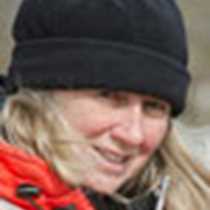Orkney, Scotland
Memories often emerge as snapshots, periods of time frozen in a single image which in turn evokes a whole tale. Such was our day. Fragments isolated by moisture-laden air reached our eyes and yet we thought we understood what was beyond our view.
The land was barely a dark smudge on the horizon although the sound of surf said it was little distance away. Water and sky differed only in their shades of gray in the early morning light. Not a breath of air rippled the surface of the sea so when undulating lines or concentric circles appeared we had to supply the image of the source ourselves. Did we see the wake of a nearby vessel or the last surfacing of a seal? This isolation from the entirety of the world brings with it a sense of calm and when blended with perfect summer weather, a desire to sit down and stare far off is often the result. There was little time for that however for we were in the heart of Neolithic Orkney and there was so much to see and contemplate.
Rolling hills draped in verdant greens and dappled with golden gorse were the backdrop for many a pastoral scene. Shiny black Angus cattle lounged about and tiny new lambs gamboled often oblivious to the ancient standing stones right in their midst. Our sense of time is tested here. Skara Brae’s exposed village showed that five thousand years ago civilization was much more complex than we might originally have anticipated. Will we ever understand the meaning of henge monuments like the Ring of Brodgar, why they were built and how? We can only look at current evidence, apply our past experiences and make hypotheses much like those we made while reading the ripples on the sea.
Kirkwall’s modern day activities were just as puzzling on this busy Saturday afternoon. Classic cars lined up in front of the ancient sandstone façade of St. Magnus Cathedral while a tractor parade dashed up and down the main street. Masquerading teens paraded amongst modern shops in a ritual of sorts (? graduation antics).
Across the water time stood still once again and in the gardens of Balfour Castle or the meadows of Shapinsay life continued much the same as it had decades ago. Waterfowl led their fuzzy progeny in and out of sedge edged pools. Curlews cried their warnings from the fields. Walled gardens sheltered fruits and vegetables in times when winds did blow and soaked up warming sunshine on this day.
It may be fortunate that the misty sea periodically wraps the land in a cottony shroud, for we might never sleep if there were more to see.




